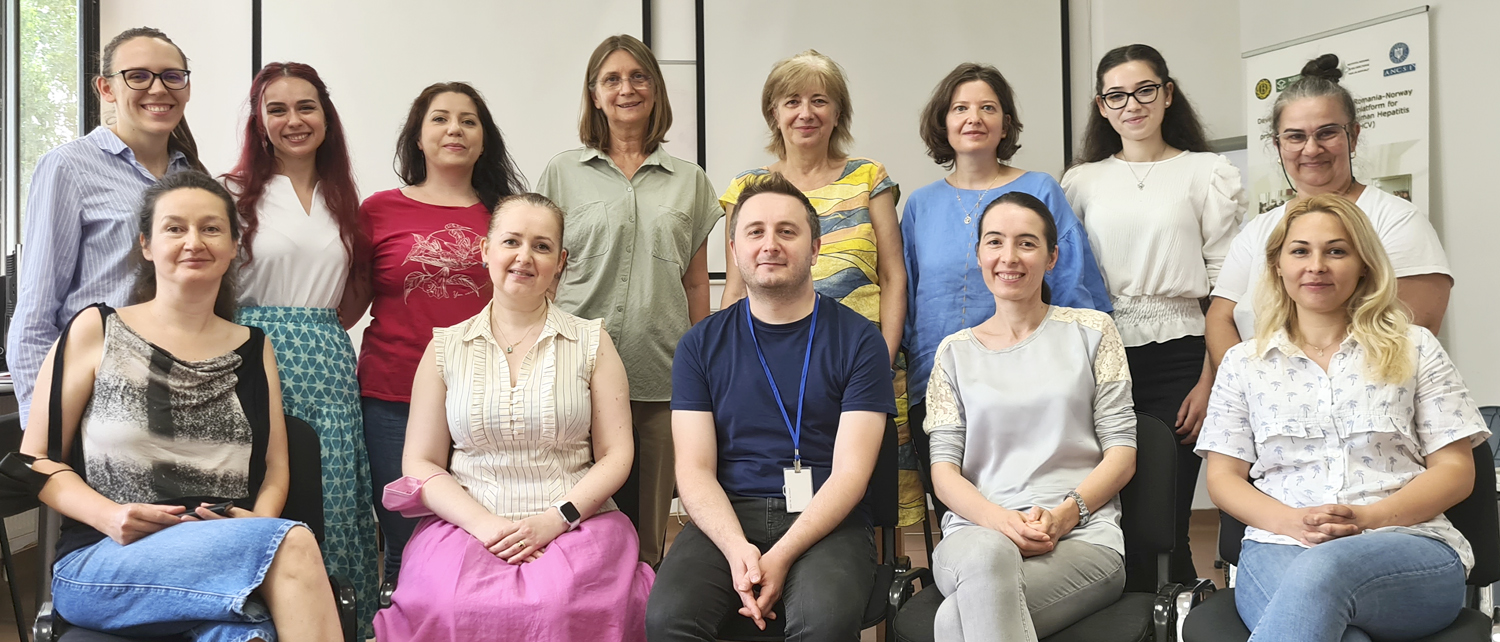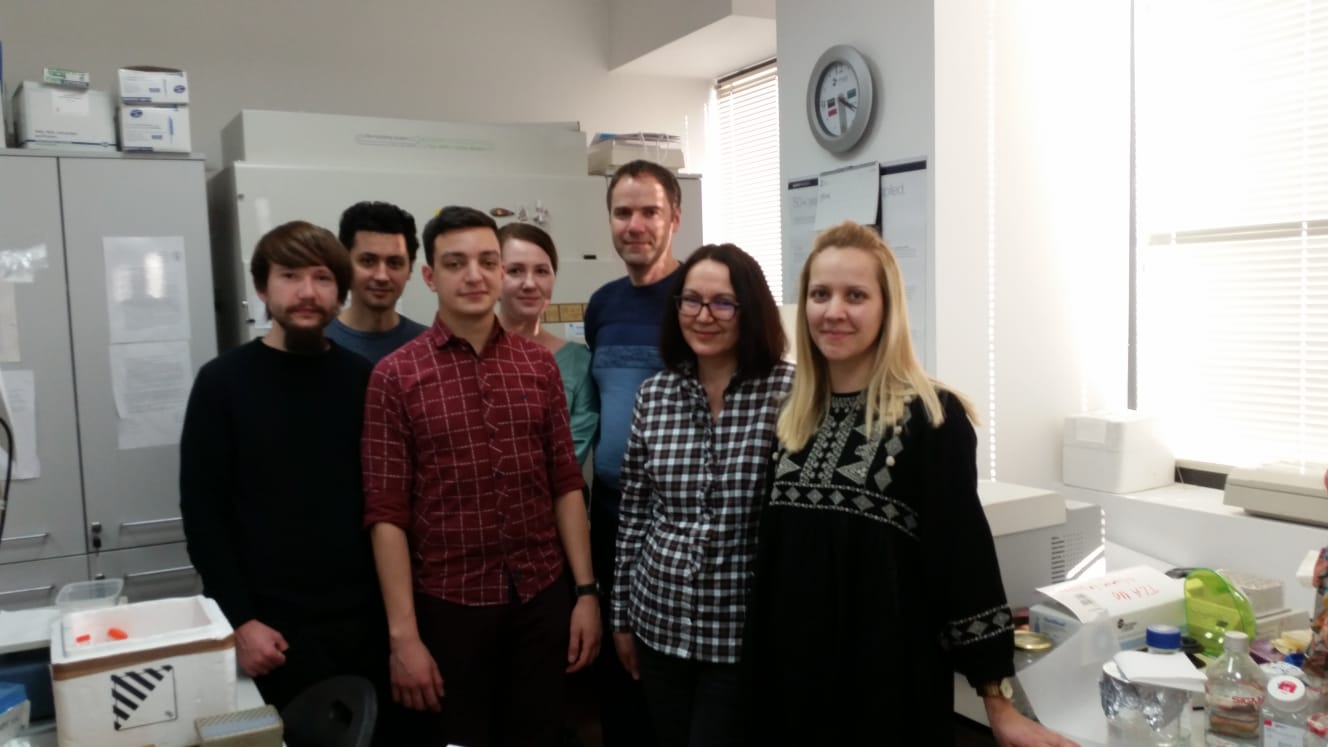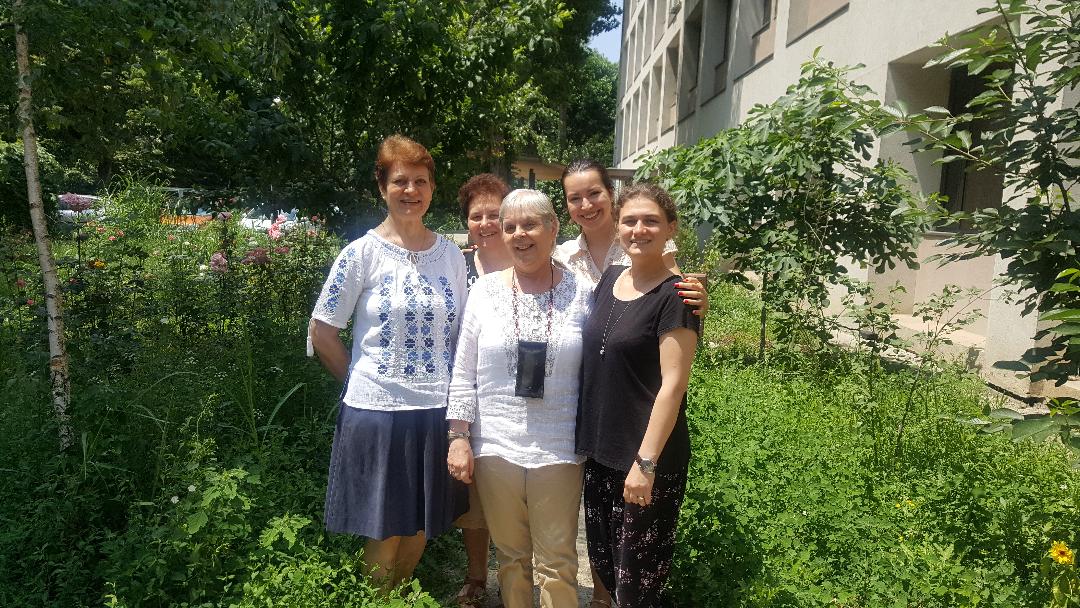
Protein homeostasis is fundamental for cell function and survival because proteins are critical facilitators of all cellular processes. Our goal is to better understand the processes that maintain the fine balance between newly synthesized and old or misfolded proteins, preserving the protein homeostasis and preventing various diseases. Current projects in the laboratory are focused therefore on processes regulating protein lifetime: protein folding and maturation, trafficking, subcellular localization and degradation. Our research explores new ways of investigating the quality control process occurring in the endoplasmic reticulum that facilitates protein secretion towards the Golgi apparatus whilst regulating degradation of misfolded proteins by ERAD pathways.
Protein processing with focus on antigen processing and presentation is currently investigated and aims at determining the exact role of ERAD components in the generation of tyrosinase-derived tumour antigens. Understanding of basic mechanisms of antigen processing and presentation to T cells will provide valuable clues to enhance the efficacy of peptide-based cancer vaccines. Deciphering the pathways mediated by the tyrosinase-related antigen, TRP-2 is another focus of our group aiming at uncovering the potential implications of this antigen in the prognostic and therapy of malignant melanoma.
We develop new tools to extend our knowledge on the role of ERAD in the endoplasmic reticulum of secretory cells. Proinsulin matures in the endoplasmic reticulum of pancreatic β−cells and depending on the ER folding capacity is either secreted or destroyed. Our hypothesis is that up-regulation of ERAD enhancers may alleviate the ER burden in pancreatic β−cells by recruiting misfolded proteins for degradation. To verify this hypothesis we use model β−cells, intact primary islets and animal models with modified ERAD and test the insulin secretion upon glucose-stimulation.

The Department of Bioinformatics & Structural Biochemistry was funded in 1999 by Andrei-Jose Petrescu who is also professor and PhD Coordinator at the School of Advenced Strudies of the Romanian Academy, SCOSAAR.
Since 1999 the initial group has functioned and gradually increased into the current structure of the Department consisting of 3 groups focussing on: 1. Structural Bioinformatics and Biocomputing; 2. Systems Biology of Ageing; and 3. Applied Proteomics and Interactomics - all aiming to consistently implement computational biology techniques in the realm of bioinformatics; systems biology, modeling & simulation and , 'omics' applications - and use them to guide experimental research in molecular biology and biochemistry.
Of the current three groups the Structural Bioinformatics and Biocomputing one continued working on structural bioinformatics - investigating in the 2000-2010's glycoprotein folding and degradation, the relation between glycosylation and glycoprotein's structure and more generally studying the biophysical aspects of protein folding and structure. Currently, the group develops techniques in this field and applies them to a variety of problems in structura biology with a significant focuss on immunobiology and molecular medicine. In 2012, Adina Milac (d. 2019), returned to DBSB from the National Institute of Health, NIH Bethesda, USA, where she carried out two PostDoc stages in Lawrence Tabak's and Robert Guy's lab. Adina brought in fresh molecular modeling and simulation techniques and new research topics related to structure-function relation in ion-channel systems and drug-design. In 2016, Laurentiu Spiridon, also returned from a PostDoc at the Illinois Institute of Thechnology in David Minh Lab. Laur who leads the molecular simulation endeavor has brought in new Free-Energy computational methods that we are currently using in ligand screening and drug design. Since his return Laur has actively worked to develop a new generation of highly efficient Gibbs sampling techniques based on robotic algorithms that have been implemented in the Robosample simulation platform.
Since 2016, DBSB greatly increased its size, with the addition of the Systems Biology of Ageing Group led by Robi Tacutu, also a DBSB-IBAR alumni, returning to the Institute from the University of Liverpool, UK. Robi's group is developing and using bioinformatics tools and multi-omics data to better understand the ageing process and age-related diseases. Robi's group has a strong multidisciplinary background, mixing gerontology, bioinformatics and machine learning techniques in order to analyze large amounts of data from heterogenous high-throughput technologies and from a wide variety of OMICS.
The third research direction pursued by the recently, 2023 established Applied Proteomics and Interactomics Group, led by Dr. Cristian VA Munteanu, also a former PhD student in DBSB-IBAR focusess on coupling computational techniques with Mass Spectrometry, Surface Plasmon Resonance and data derived from the high-throughput Drug Screening Platform of the Institute, aiming to step up the scale of biological system investigation to the global proteome and interactome level.
Currently given their unique expertise in Bioinformatics, Biocomputing and Proteomics all of the three DBSB groups are heavily involved, among others, in delivering highest quality research in two major FEDR funded consortium projects of national interest: ROGEN - Developing Genomic Research in Romania (2024 - 2029) and CANTAVAC - Development of Translational Research for Vaccines, Serums and other Biological Medicines (2024 - 2029)
Major Awards: Along the years DBSB was the recipient of 5 Romanian Academy Awards:
1. Romanian Academy Award "Nicolae Simionescu" 1998: Petrescu A.J. for "Contributions in Protein Folfing Research"
2. Romanian Academy Award "Grigore Antipa" 2017: Spiridon L. for "Development of Highly Efficient Simulation Methods"
3. Romanian Academy Award "Emil Racovita" 2020: Tacutu R. for "Contributions in the System Biology of Aging"
4. Romanian Academy Award "Emanoil Teodorescu" 2023: Munteanu C.V.A. for "Contributions in Mass Spectrometry based Proteomics"
5. Romanian Academy Award "Grigore Antipa" 2025: Martin E.C. for "Contributions in Molecular Immunobiology"
DBSB infrastructure: The department is supported by the Protein Chemistry Facility and the computational infrastructure provided by the High Performance Computing Centre, one of the central facilities of the Institute vital to our molecular simulations and bioinformatics analyses consisting in:
12 Biocomputing dedicated Graphic Workstations (overall power ~250 TFlops, storage 70 TB)
1 Biocomputing dedicated HP-HPC Cluster (4 TFlop - effective power, storage 16 TB);
4 Systems Biology dedicated storage/analysis servers (overall storage 200 TB)
5 Systems Biology dedicated Workstations
1 General use Bull-HPC Cluster

The Viral Glycoproteins group was founded in 2002 with the aim to apply the methods developed in the Institute for the study of glycoprotein folding, to a more specific but highly challenging field of molecular biology . the viral envelope packing. The group works in collaboration with the Molecular Cell Biology group and also with colleagues from the Department of Biochemistry, University of Oxford, UK and the University of Lyon, France. Human hepatitis B and C viruses cause infections of the liver. Worldwide more than 400 and 100 million people are chronically infected with HBV and HCV, respectively. More than 150 million are likely to die from liver disease in the absence of intervention. For HCV, no vaccine is available and the only possible treatment is the interferon alpha therapy on its own or in combination with ribavirin. However, few patients respond to interferon, the side-effects are often severe and relapse is common after treatment is stopped.
Currently available anti-HBV drugs target virus-encoded enzymes and when used in monotherapy often give rise to resistant viral mutants. Therefore, development of new drugs, which are less likely than current ones to succumb to viral resistance, are urgently needed. Our group has been focused on studying iminosugar derivatives as antiviral agents against both HBV and HCV. Viruses that encode one or more glycoproteins are likely to depend on the host-cell mechanisms of protein folding and quality control for proper assembly and morphogenesis. The ER- resident α-glucosidases I and II perform the stepwise removal of the three glucose residues on N-linked glycans attached to nascent polypetides, enabling folding intermediates to associate with the lectin-like chaperones calnexin and calreticulin, which in turn, promote folding and prevent premature oligomerization and aggregation. Thus, targeting the ER-α glucosidases may potentially be of therapeutic use in treating viral infections. We have shown that by inhibiting these enzymes using the glucose-analogue iminosugar derivative, N-butyl-deoxynojirimycin (NB-DNJ), secretion of HBV and BVDV (a tissue culture model for HCV) from infected cells is impaired. Moreover, both, HBV and BVDV particles secreted in the presence of this drug are less infectious. The current projects of the group aim at improving the antiviral activity of this class of drugs, by enhancing delivery following incorporation into ER-targeted liposomes. The study of HBV entry into hepatocytes and development of new drugs acting early in infection are also important issues currently addressed by our group.

The biological processes that occur within all living organisms are chemical reactions, and most are reguated by enzymes. Without enzymes, many of these reactions would not take place at a perceceptible rate. Enzymes catalyze all aspects of cell metabolism.
Our central research topic is the study of structure-function relationships in signaling enzymes, with a focus on protein tyrosine phosphatases. The aim is to contribute to the understanding of how their structural features are correlated with specific signaling functions. To this end, signaling enzymes are studied from several directions:
- as a classical enzyme, trying to evaluate enzymes stability under different conditions, the pH dependence of the activity, the specific activity, the kinetic parameters at the steady state, the substrate specificity and also the identification of the specific inhibitors
- as a protein, trying to crystallize the purified enzyme preparation and then determine its 3D structure
- as a signaling entity, trying to find its subcellular location, substrate(s), regulatory interactions, role played in signaling pathways, etc.
The combination of results thus obtained in this way is further used to shed light on the signaling mechanism and overall functional role of the given enzyme.
We have good experience and we are currently involved in the production, isolation and purification of recombinant proteins, expressed in both prokaryotic and eukaryotic systems. Our research activity is carried out through tools of molecular biology (recombinant DNA, site-directed mutagenesis, (RT)-PCR, Western blot, immunoprecipitation, etc.), spectroscopic analysis (UV-VIS and fluorescent spectrophotometry), cell biology, protein crystallization and enzyme kinetics.
Our ongoing research projects are:
- Design, preparation, characterization and testing of new molecular vectors targeting specific leukemic cells for targeted diagnosis and targeted therapy
- Study of tau protein acetylation and its involvement in neurodegenerative diseases

Lactoferrin (Lf) is an iron binding glycoprotein of transferrin family, present in almost all mammalian secretions and neutrophils. A variety of biological functions have been ascribed to Lf, including anti-inflammatory and immunomodulatory effects. The protective action of Lf during inflammation is related to its influence on cytokine production and capacity to bind potentially toxic iron at inflammation foci. In our previous studies performed in collaboration with the Department of Clinical Bacteriology, University of Goteborg, we found that LPS (lipopolysaccharide) -induced cytokine production, in particular TNF-a, IL-1β, IL-6, are inhibited by Lf. The binding of protein to LPS could partly explain its inhibitory activity since the effect could be seen when Lf was added before as well after cell stimulation. This suggests that other mechanism(s) than simple LPS scavenging property of Lf is (are) responsible for the inhibitory activity.
In this respect, our group approaches two aspects:
The mode of action of Lf on intracellular signal transduction pathways.
Our preliminary results showed that Lf is taken up by monocytic cells. Therefore it is possible that Lf, following the binding to the cells, might affect some intracellular pathways involved in the cell response to external stimuli such as bacterial endotoxins. LPS stimulation of monocytes has been shown to induce the activation of three subgroups of MAPKinase familly-p38, ERK1/2 and JNK. These enzymes play an important role in the control of proinflammatory cytokine production mediated by LPS. We propose to study the effect of Lf on the phosphorylation and activation of MAPKinases in the presence/absence of LPS. The results will be related to the effect of Lf on the LPS-induced cytokine production in monocytic THP-1 cells. This aspect involves collaboration with Dr. Inger Mattsby-Baltzer group from the Department of Clinical Bacteriology, University of Gothenburg, Sweden.
The anti-inflammatory properties of Lf in vivo: use of liposomes as possible carriers for Lf in the treatment of Rheumatoid Arthritis.
Exhibiting antimicrobial and anti-inflammatory activities Lf could have therapeutic potential in arthritic disease. We are investigating the ability of free and liposome-entrapped Lf to reduce inflammation when administrated to the joint. Current studies aim to establish the suitable liposomal formulation able to deliver Lf efficiently into the joint of mice with collagen-induced rheumatoid arthritis.Liposomes-entrapped Lf is expected to serve as a better tool and therapeutic agent against inflammation. This part is developed in collaboration with Dr. James Brewer group from the Department of Clinical Immunology, Glasgow University, UK, coordinated by Prof. F. Y. Liew.
The project should provide important information for understanding the anti-inflammatory activity of Lf in vivo.